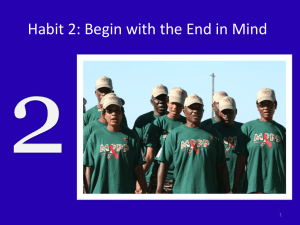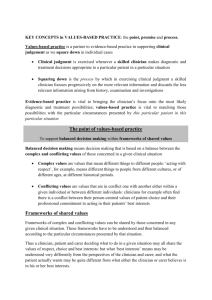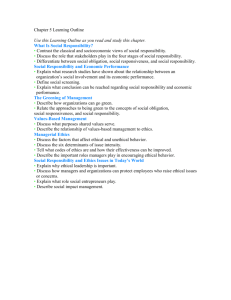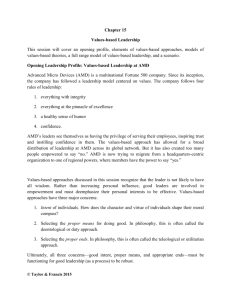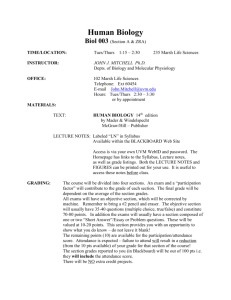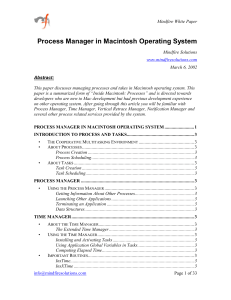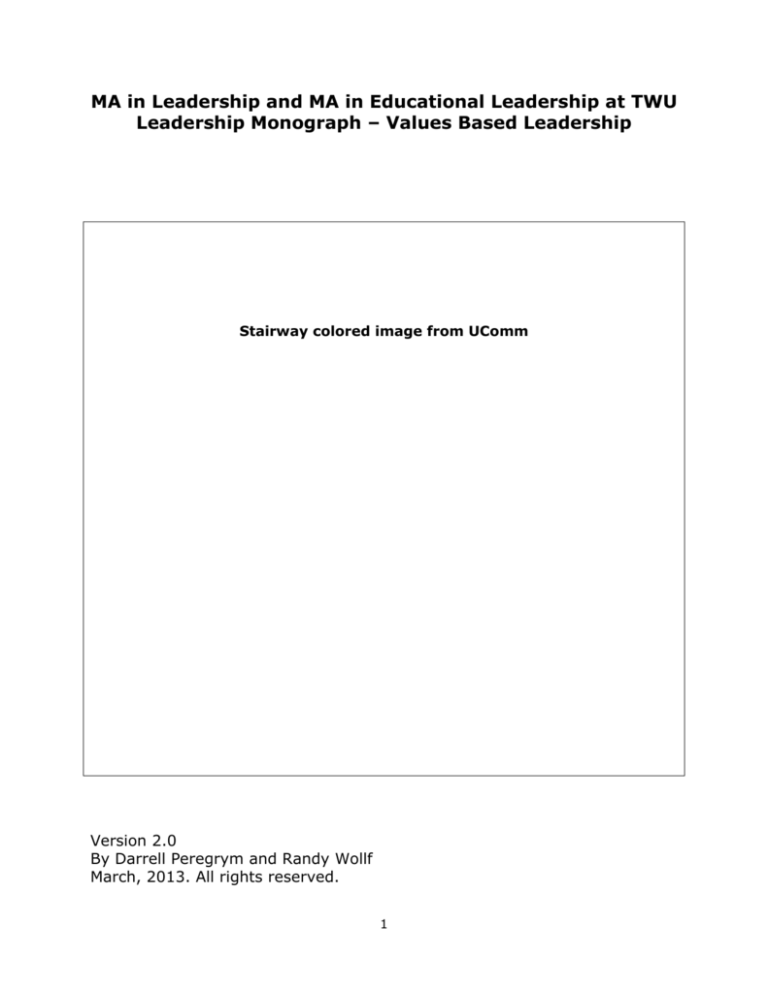
MA in Leadership and MA in Educational Leadership at TWU
Leadership Monograph – Values Based Leadership
Stairway colored image from UComm
Version 2.0
By Darrell Peregrym and Randy Wollf
March, 2013. All rights reserved.
1
LEADERSHIP COMPETENCIES
2
VALUES BASED LEADERSHIP
The MA in Leadership (MA Lead) and MA in Educational Leadership (MAEL)
degrees at Trinity Western University (TWU) feature two foundational elements:
Transformational Servant Leadership (TSL) and Values-based Leadership (VBL). At
the core of the leadership competency model for the MA Lead/MAEL programs is
TSL values and ethics (MA in Leadership Program, 2012). The purpose of this paper
is to establish the significance and critical necessity for VBL in TSL. TSL requires a
strong orientation to values that allow leaders to serve their people well while
engaging in efforts that transform the organization. In the first section, we provide
a brief literature review on the various definitions and perspectives on VBL and
propose a definition of VBL. The second section focuses on how we might discern,
critique, live out and develop personal values in ways that contribute to a robust
form of TSL. The final section introduces case studies corresponding to the five
streams in the MA Lead/MAEL programs (business, Christian ministry, non-profit,
education and health). This section also presents a brief description of how VBL
permeates the MA Lead/MAEL programs themselves.
Definitions
In order to understand VBL, it is important that we first define what we mean
by values. Then, we can move on to explore the nature of VBL.
Values
Rokeach, a major contributor to the study of personal values, defined a
personal value as an “enduring belief that a specific mode of conduct or end-state
of existence is personally or socially preferable to an opposite or converse mode of
conduct or endstate of existence” (1973, p. 5). Wilson (2004) maintains that
Rokeach’s psychological definition of personal values is the most frequently cited
definition of human values. Rokeach believed that people have a finite number of
values and an infinite number of attitudes that arise out of these values. McCarty
and Shrum (2000) concur with Rokeach and assert that values serve as prototypes
for subsequent behaviours and attitudes.
Lopper, author and personal life coach, believes “values are deeply held
beliefs about what is good, right, and appropriate” (2006, para. 1). He contends
that they are deep-seated and remain constant over time. Lopper asserts that we
accumulate our values from childhood based on teachings and observations of our
parents, teachers, religious leaders, and other influential and powerful people. In
fact, we would contend that our involvement in various communities throughout our
lifespan not only contributes to the adoption of core values, but to their subsequent
shaping.
Ganly states that “personal values are the essences of who we are as people
and human beings” and as such, it is therefore “important to understand and
recognize your own personal values” (2010, para. 2). Ganly believes that we
develop our personal values throughout life and that they impact both our personal
and work lives. Personal values impact work performance because they reflect who
we are and how we act in any setting. The reason that personal values have such
power is that they are foundational elements of character (BHO Group, 2009):
3
Values are the fundamental building blocks of character that outline who we
really are inside – what makes us unique. For the most part, values involve
our interaction with people. They’re the internal rules that tell us how to treat
ourselves and others. (p. 8)
This definition is consistent with Rue’s (2001) understanding of personal values:
Values are the essence of who we are as human beings. Our values get us
out of bed every morning, help us select the work we do, the company we
keep, the relationships we build, and, ultimately, the groups and
organizations we lead. Our values influence every decision and move we
make, even to the point of how we choose to make our decisions. (p. 1)
Rue adds that our values are the elements deep within our belief system that make
us “tick.” They influence every aspect of our perceived reality. Hyrum Smith from
the Franklin-Covey Company refers to our belief system as the screen through
which we filter our view of the everyday world (Smith, 2000).
Schwartz and Boehnke (2004) found five characteristics of values
consistently reported in his review of the literature on values: Values are 1) beliefs,
2) relate to desirable end states of behavior, 3) guide evaluation of behaviors or
events, 4) remain stable across time and context, and 5) are ordered by relative
importance. He contends that values are learned beliefs that function as guiding
principles regarding preferred ways of acting or being (Olver & Mooradian, 2003).
These values are often quite intransient. Page claims, “You can train a person in
the ways of the organization but you can seldom, and only with much work over a
long period of time, really change a person’s values” (2009, p. 144). Of course,
individuals generally give themselves considerable latitude in the expression of their
values with the result that they appear to have multiple identities. In reality, they
are simply expressing diverse attitudes and behaviours in keeping with their values
and their context which may require certain values expressions. Yet, this view is
problematic in at least two major ways. First, it assumes that individuals always
align their attitudes and behaviours with their values. This position is untenable as
there are personal factors such as mood and external factors like the expectations
of others that might influence people to act contrary to their values. A second
problem is that the view assumes that external factors influence the expression of
values via attitudes and behaviours, but often lack the power to change the values
themselves. This approach may allow for values change due to personal crises, but
it does not allow for the gradual shaping of values. Graber and Kilpatrick (2008, p.
183) discovered in their study on establishing values-based leadership and values
systems in healthcare organizations that “individual value systems, whatever they
may be at the inception of professional education, are influenced and modified in
the course of professional education.” Personal values may not be as intransient as
Schwartz and others originally believed.
For the purpose of this paper, we assume that personal values are defining
characteristics that tend to prevail over time, often have a determinative influence
on our attitudes and actions, and can express themselves in many different ways.
However, these expressions, as seen in attitudes and behaviours, may appear
4
contradictory and may even reflect adherence to contradictory values (or values
that oppose each other in certain situations). As people reprioritize their values, the
resultant values’ expressions may differ significantly from previous expressions. We
also acknowledge that even though core values tend to prevail over time, major life
events, sustained values-shaping efforts on our part, and divine intervention can
have a profound impact on our core values.
Values Based Leadership
The literature on VBL tends to fall into two major categories: literature that
focuses on understanding your core values and expressing them consistently and
literature that prescribes certain values as being necessary for effective valuesbased leadership. One’s definition of values-based leadership depends on how much
you draw from each of these categories to formulate your definition.
Understanding and Applying Personal Core Values
Kraemer (2011), former CEO of Baxter, proposes four principles of VBL in his
book, From Values to Action. He maintains that values-based leaders, first of all,
understand their values through regular times of self-reflection. As Rue (2001, p.
14) suggests, “It takes courage to face our authentic self and make the
commitment to protect and care for that authentic self.” This process of selfreflection helps us to make the best choices for ourselves. Badaracco (1997), in his
work on defining moments, believes that meaningful reflection is an important part
of resolving defining moments well.
Yet, Kraemer (2011) also insists that values-based leaders go beyond selfreflection and are concerned about the values of others. It is unconscionable to
apply our personal core values in the workplace without due consideration of the
values of others. According to Kraemer, values-based leaders practice balance by
listening to the ideas of others and discerning the personal values that undergird
those ideas. They seek to pool the wisdom of others and try to make the best
decision for those involved and the larger organization without compromising their
personal values. This requires learning other peoples’ “languages” (Nash, 2002). Of
course, leaders sometimes discover during this communal sense-making process
that they need to allow others’ values to shape their own. The key to truly hearing
people is open and transparent communication that allows people to get beneath
ideas and share about their beliefs and defining moments that have shaped their
ideas. Nash observes that when people in a group share openly at this level, they
begin to construct meaning bridges within the group. These meaning bridges foster
understanding and respect and can ultimately help the group work together to
make wiser, more ethical decisions. It provides a context for values-based leaders
to apply their personal core values in a respectful and equitable kind of way.
In addition to self-reflection and practicing balance, Kraemer (2011) believes
that living out one’s personal values requires true confidence. This confidence
grows, in part, as we understand our core values and increasingly align our actions
with those values. Of course, this values-action alignment requires a strong
commitment to our values and discipline in their application as we face threats and
distractions. Yet, true confidence also allows leaders to listen to and incorporate the
ideas of others (thus practicing balance). Confident leaders are often courageous
5
leaders. Lee (2006) asserts that courage is the backbone of leadership – it helps us
to activate our values.
Kraemer’s (2011) fourth principle of values-based leadership is genuine
humility. He believes that genuine humility allows leaders to be authentic – to truly
live out their personal values while respecting the values of those around them. “At
the heart of genuine humility is never forgetting who you are, appreciating the
value of each person in the organization, and treating everyone respectfully
whether she is a senior manager or a summer intern” (Kraemer, p. 60). True
confidence helps us to demonstrate this kind of humility. As we recognize
everyone’s value and believe that we are not more important than others, we are
more likely to practice the principle of balance. In the end, humility allows valuesbased leaders to truly lead people – to bring their values to bear on others’ lives in
an acceptable and meaningful way and to provide ways for other organizational
members to do the same.
Aspiring to Prescribed Core Values
Other authors advocate certain values as being superior to others. For
example, Don Knauss (2007), Chairman and CEO of the Clorox Co., emphasizes
five essential values for values-based leaders: integrity, curiosity, compassion,
humility and optimism. The Building Healthy Organizations Group (BHO, 2009)
describe five areas where we form values that influence the health of workplace
relationships: value (the extent to which we esteem peoples’ inherent worth),
aptitude (aligning tasks with peoples’ abilities), learning (developing the whole
person), unity (helping people function as a team) and empathy (caring for people).
These areas reflect a servant leadership perspective. In fact, the BHO Group is
convinced that “anything other than a servant leadership model has an inherent
danger of devaluing people” (BHO, p. 156). They conclude with a statement about
the values that must undergird this process: “In healthy organizations, the
commitment is to respect, trust, and serve people” (p. 157). Based on our strong
orientation to TSL in the MA Lead/MAEL programs, we believe that values-based
leaders must incorporate the values associated with TSL into their leadership.
Based on the work of Robert Greenleaf, Spears (2010) articulated 10 characteristics
of servant leaders: listening, empathy, healing, awareness, persuasion,
conceptualization, foresight, stewardship, commitment to the growth of people, and
building community (see the MA Lead/MAEL Transformational Servant Leadership
monograph for an extensive treatment of the topic). Writing from a Christian
perspective, Hill (2007) maintains that love, justice and holiness are overarching
values of God. Thus, Christians whom God calls to imitate Himself (Ephesians 5:12) should seek to emulate these values and others that reflect His character. The
Bible provides much guidance as to the kinds of values Christians should embrace
and how they might express them in God-honouring ways. We would add that
wisdom is also an essential value, as wisdom helps us know how we might best
shape, prioritize, and express our values. Holmes (1984), a noted Christian ethicist,
narrows the list down to love and justice. Of course, if the greatest commandment
in the Bible is to love God and others (Matthew 22:37-39), perhaps we could say
that the ultimate value for Christian values-based leaders is love. Hester (2012)
comes at the question from a different angle, but arrives at a similar conclusion. He
6
appeals to a feminist ethic of care that lifts “care and compassion, love and genuine
concern for others as a foundation of values-based leadership” (p. 44).
Combining the Two Approaches
We would suggest that combining the two approaches results in a stronger
VBL model. VBL certainly involves knowing our core values and exercising desirable
ones appropriately and consistently in our leadership. Yet, one of the shortcomings
of this approach is that it does not provide guidance on which values are desirable.
We believe that VBL goes beyond self-awareness and application of existing values;
it involves a critique of one’s existing values in light of one’s life purpose,
contextual factors, community affiliations and the central texts (e.g. the Bible) that
one embraces as ultimate guides in life. Do I have the right values for helping me
live out my life purpose? Are my values (and their expressions) appropriate for my
context and the communities represented within that context? Are my values
consistent with the central texts that serve as moral compasses in my life? If not,
which values do I need to minimize and which values do I need to strengthen or
add to my roster of core values? When faced with particular decisions, do I
sometimes need to reprioritize my values? For the rest of this paper, we define VBL
as consistently leading out of personal values that are both desirable and beneficial
for ourselves, those in our communities, and/or the organizations we serve. As a
part of this definition, we recognize that VBL often requires transformational
servant leaders to lead courageously when their personal values are contrary to
those of people around them. Yet, we also believe that leaders who desire to
practice VBL must also be transformational servant leaders who are sensitive to
their surrounding communities and who allow their values to shape and be shaped
according to what would be most transformative for the organization and its
members.
A Description of Values-Based Leadership
Having established a definition of VBL, the next critical step is to describe
how we discern, critique, live out and develop personal values that benefit others,
our organizations and ourselves.
Discerning Our Personal Values
Discerning our personal values involves self-reflection. What makes us act
and react the way we do? Through what screens do we view and respond to life?
On what basis do we make decisions? Questions, like those in the following list, can
assist with the values discernment process:
1. What is important to me?
2. What makes me feel fulfilled?
3. What make me feel angry or indignant?
4. What makes my life meaningful?
5. What makes me feel fulfilled and gets my adrenalin flowing?
6. What influences my decision-making process?
7. How do I like to be treated?
8. How do I treat others?
7
We can also begin to clarify our values be creating a personal timeline of
defining moments or seasons in our life. What are some of the pleasant and painful
experiences that have shaped us? What are some of the themes that were
reinforced across multiple defining moments? What are the underlying lessons that
we learned (or perhaps should have learned) through those life-shaping events? As
we look at the individual defining moments and some of the thematic connections
between them, we will be in a better position to see how our life experiences have
shaped our personal values.
Some examples of values are honesty, integrity, compassion, trust,
forgiveness, accountability, change, excellence, justice, mercy, hospitality,
generosity, humor, fun, loyalty, order and cleanliness. Many personal development
organizations have produced lists of personal values. It is often beneficial to look at
these kinds of lists as often certain value descriptors will resonate with our
experience. We can list dozens of relevant value descriptors, but generally the
significant, or “core values” that define us will not exceed six to eight in number.
Lee (2006) maintains that there are three levels of values: low values
(common habits like productivity and a results orientation), middle values (best
practices like teamwork and innovation) and high values (overarching values like
integrity and courage). Values-based leaders must have high values that permeate
all of their decisions and that result in positive benefits for themselves, their
communities and their organizations. Yet, they must also have strong middle and
low core values that allow them to serve with excellence.
Understanding our personal values paves the way to making the best choices
in keeping with what is most important to us. Choosing to remain ignorant about
our personal values puts us at a disadvantage, as we may make decisions that are
out of alignment with what matters most to us. However, as we become more
aware of our personal values, we may realize that they are inadequate to support
the behaviours necessary to live out our sense of purpose within a particular
context. Critiquing our core values is an important part of the process of developing
robust personal values that will serve us and others well as we practice VBL.
Critiquing Our Personal Values
Values-based leaders take the time to not only discern their personal values,
but also to critique them to make sure they are both desirable and beneficial for
themselves, their communities and organizations they serve. Some may refer to
this process as values alignment. In this kind of evaluative process, it is helpful to
have an overarching sense of purpose for one’s life. Do my current values help me
achieve my life purpose? If they do not contribute in a substantive way, what
values do I need to strengthen? One can also compare one’s values with central
texts that provide a moral compass for one’s life. How do my values measure up to
the values honoured in those texts? It is also important to compare one’s values to
those in the communities that are important to us. In order to thrive and serve in
transformational ways within those communities, do I need to adjust my values? As
we critique our personal values, we are in a better position to live out values that
are more beneficial to ourselves and those around us.
Living Out Our Personal Values
Living congruently with one's values is fulfilling while living in conflict with
8
one's values is both unfulfilling and stressful. Lopper (2011) believes that stress
does not result from hard work, long hours, or multiple roles in life. Stress results
primarily from values conflicts. When people are in situations where they are unable
to honor their personal values, they will feel stressed and no amount of relaxation,
meditation, or exercise will eliminate the stress until they resolve the values
conflict. Addressing this tension may involve adjusting one’s values (or at least the
way we prioritize them), advocating one’s values despite the tension, or moving
away from the situation that is creating the values dissonance. Understanding one’s
life’s purpose and gleaning from the wisdom of others can help to clarify which
direction is best. For Christians, committing the matter to prayer and listening to
God’s voice through Scripture will not only help with discerning the appropriate
course to take in the future, but can provide the necessary strength to navigate the
turbulent waters in the present.
For leaders, living out their personal values gives them a great advantage in
shaping their organization’s culture. Leaders who practice their personal values set
a clear example to others. They are aware of why they make decisions and how
those decisions impact the people around them. They have an internal guidance
system, which some might call a conscience. This internal GPS helps them make
the tough choices and feel confident and courageous in their decisions.
Rue (2001) says leaders who are in tune with their personal values and live
in harmony with them tend to be more positive and find greater satisfaction in life
and work. They tend to form trusting relationships more readily. Multiple life studies
reveal they live healthier lives. They are comfortable with themselves, and they
treat themselves and others with compassion, respect and care.
Developing Our Personal Values
As indicated earlier, we develop our personal values through family
interactions (especially during the early, formative years), ongoing connections with
people in various communities of which we are a part, faith experiences,
educational influences, life situations and workplace experiences. Ganly (2010)
believes that the development of personal values is a lifelong process that affects
all areas of life. Personal values develop through experience and learning. She
believes our personal values form and reform over time and impact our personal
lives as well as our professional lives. In contrast to this position, the BHO Group
(2009) believes that our values rarely change. When they do, it is usually because
of a very difficult experience, “the kind of experience that leaves us questioning our
purpose in life” (BHO, p. 9). They further state that if our values are out of sync
with our priorities, our actions will continually fall short of our intentions and our
consciences will bother us incessantly.
Whether one leans towards Ganly (2010) or The BHO Group (2009), it is
obvious that the development of strong personal values is essential to ongoing
personal growth and increasingly effective service as transformational servant
leaders. It is also clear that understanding our personal values is important to who
we are, how we behave, and the influence we have on ourselves and others.
Many organizations have produced a variety of helpful tools and guidelines
for developing one’s personal values. For the purposes of this paper, an overview
and compilation of some of them provides the following starting points for personal
consideration:
9
1. Identify all value descriptors that you feel are relevant to you personally.
2. Discern your “core” personal values (no more than six to eight). Look for
core values that will help you live out your life purpose in a maximum way,
that are compatible with the communities that are important to you and that
align with the central texts that serve as moral compasses in your life.
3. Define those core values clearly. For example, if you choose “excellence” as
a value descriptor, what does excellence mean to you? For example, your
statement regarding excellence might be, “I will strive to do my best in every
situation in light of the resources at my disposal.”
4. Create a checklist of specific value-based guidelines that are in line with the
value statement. Again, using excellence as an example, some of your
guidelines might be:
a. I will stay updated on _____ (the subject you want to excel in).
b. I will give 100% in everything I do and will not settle for less.
c. Just enough is not good enough.
5. Implement your personal values. For a pre-determined timeframe (15-30
days), resolve to make all decisions with your set of core values in mind.
Everything you do should support your personal value system. At the end of
your pre-determined timeframe, review and identify where you excelled and
where you fell short with the focus on improving the growth areas in the
future.
6. Find an “accountability partner” who can hold you accountable to your own
core values. This person should be someone you trust and who knows you
very well.
Conclusion
People experience significant personal strength, confidence and power when
they discern their values, adjust them to make sure they are balanced and healthy,
and create ways to honor them through their actions and decisions. In the next
section, we will look at real life examples of values-based leaders who have
demonstrated strong personal values that have had a profound impact on their
organizations.
Examples of Values-based Leadership
In the previous sections, we have defined and described VBL. With this
strong theoretical foundation in place, we will now look at four examples of VBL in
business, Christian ministry/non-profit, education and healthcare. We will also
explore how VBL undergirds the MA Lead/MAEL programs.
Business
With revenues topping $60 billion in 2011, Caterpillar is the world's leading
manufacturer of construction and mining equipment, diesel and natural gas
engines, industrial gas turbines and diesel-electric locomotives (Caterpillar, 2012).
The company also is a leading services provider through Caterpillar Financial
Services, Caterpillar Remanufacturing Services, Caterpillar Logistics Services and
Progress Rail Services.
However, in the late 1980s, Caterpillar found itself at a critical crossroads.
The market, economy and customer expectations had changed. The company was
10
experiencing heavy financial losses, employees were bitter and unengaged and the
company culture was caustic. The Track-Type Tractor Division, of which Jim
Despain was the Vice-President and General Manager, was losing tens of millions of
dollars each year. After trying every standard approach (e.g. Total Quality Control,
cost cutting, equipment upgrades), Despain and his team of managers introduced a
radical approach which focused on the leadership, the company culture and the
employee’s work experience (Despain & Converse, 2003). Their honest look in the
mirror led to the development and implementation of a VBL model they called, “Our
Common Values,” which emphasized values such as trust, mutual respect,
teamwork and empowerment.
In the book, ...And Dignity for All, Despain (Despain & Converse, 2003)
describes his experience of VBL while serving as a manager in Japan. He
encountered a Japanese leadership concept called kaizen, which emerged in Japan
following World War II. The word Kaizen means "continuous improvement." It
comes from the Japanese words 改 ("kai") which means "change" or "to correct"
and 善 ("zen") which means "good." Kaizen is a system that encourages every
employee from upper management to the cleaning crew to look continuously for
ways to improve the workplace.
One year after implementing the “Our Common Values” model, there was a
noticeable shift in the company culture resulting in a more positive experience for
employees and customers. Less than three years after the introduction of the
values model, Despain’s division showed a profit. Within five years, the division had
cut its break-even production point by 50%, increasing profits consistently on a
yearly basis.
In looking back over his experience with VBL at Caterpillar, Despain
concludes:
Over the years we proved, without a doubt, that the right behavior produces
the right results. Values-based leadership is also a process – a human
process. The better and more consistent the values-based leadership process
is, the better and more consistent are the organization’s results. (Despain &
Converse, 2003, p. 188)
Ministry/Non-Profit
John and Deanna Hayes are the General Directors of InnerCHANGE, a
mission that works among the poor in five countries. The mission’s approach is to
“share the Good News in words and works through personal relationships” (Hayes,
2006, back cover). In his book, “sub-merge,” Hayes presents personal examples of
how building authentic faith-based relationships can change the world and
communities one person at a time.
sub-merge tells the story of an approach to incarnational ministry that
propels Hayes and his colleagues to live in the communities and cultures they
desire to impact. Their approach is to love and affirm the dignity of all while caring
for and meeting their needs. This ministry focus does not rely on buildings or
programs, but on living out one’s values amongst the people one is trying to touch.
Instead of trying to draw in the lost and the poor, the approach is to go out to them
11
- to live out one’s values and the Gospel message among the people. Jesus used
this same incarnational approach when he came to live amongst his creation.
InnerCHANGE missionaries are regular people who live in neighbourhoods
around the world as church planters, community partners and organizers, local
workers and most importantly, neighbours. They live and lead by their values, and
in doing so have made a significant difference in the lives of individuals and
communities globally. They follow the examples of other incarnational values-based
leaders like St. Francis of Assisi and Mother Teresa. Their actions align with Dr.
Bobby Clinton’s statement, “Effective ministry flows out of our being, not just our
doing” (Hayes, 2006, p. 18).
Education
Leaders at the University of Denver’s graduate business program developed
a leadership model “that starts with the bricks and mortar foundation of values and
ethics” (Plemmons, 2002, p. 40). The Daniels College of Business (2012) provides
“rigorous training in business fundamentals coupled with values-based leadership
and ethical decision making.” The program combines broad exposure to literature
on ethical leadership with experiential learning that forces learners to evaluate and
even reshape their personal values. An important part of the experiential learning is
a three-day camp experience, which involves team-based activities, reflective
journaling and peer feedback. With decades of research to support their contention,
Kouzes and Pozner (2007) maintain that one of the five practices of exemplary
leaders is to model the way – to clarify one’s values and to live them consistently
before others. The University of Denver’s graduate business program seeks to help
students with this discernment and application process so that they grow solid
values that will have a positive impact on their organizations and those they serve.
Health
When Al Stubblefield, Chief Operating Officer and later CEO of the Baptist
Health Care Corporation, told board members in 1995 that the organization would
go from the eighteenth percentile in patient satisfaction to the seventy-fifth
percentile in nine months, one board member told him that he had set them up for
failure (Stubblefield, 2005). What the doubting board member may not have
realized was that Stubblefield had an unflinching commitment to the value of
service excellence. Over the next nine months, Stubblefield implemented measures
in keeping with this value, which resulted in patient satisfaction exceeding the
seventy-five percentile goal. Stubblefield’s strong commitment to service excellence
drove him to create and maintain a great culture, select and retain great
employees, continuously develop great leaders and hardwire success through
systems of accountability. One of the results has been that the organization has
made it onto Forbe’s list of the top 100 companies to work for every year since
2002. VBL made a difference for countless patients and employees in this
healthcare organization.
Values-based Leadership in the MA Lead/MAEL Programs
The MA Lead/MAEL programs at TWU have a strong VBL orientation. Values
such as integrity, authenticity, transparency, respect, compassion and forgiveness
permeate the programs (Rose, 2012). Because of our strong commitment to TSL,
12
we strive to live out the 10 characteristics of servant leaders mentioned earlier
(Spears, 2010). As learners in the MA Lead/MAEL proceed through their program,
they should see desirable leadership values in their instructors and other program
staff. The content of courses and the way instructors deliver content should
reinforce these kinds of values. For example, in the MA Lead/MAEL programs we
believe in the importance of experiential learning as a way to appropriate and
personalize ideas and skills, often while building a sense of team with others.
Whether it is supporting each other on the TWU Challenge Course or discussing
case studies in small groups, we believe that learners can accelerate their learning
and values-shaping through these kinds of team activities.
Conclusion
We believe that it is impossible to be effective transformational servant
leaders without practicing VBL. Therefore, it is imperative that MA Lead/MAEL
learners and faculty/staff commit themselves to discerning their personal values,
critiquing them against their life purpose and other standards/values, developing
values that will bring maximum benefit to themselves and others, and to then live
those values consistently so that they produce like values in the people and
organizations they serve. Then, we will be in a strong position to demonstrate a
robust form of TSL that can have a significant local and global impact.
13
References
Badaracco, J. L. (1997). Defining moments: When managers must choose between
right and right. Boston, MA: Harvard Business School Press.
BHO Group (2009). Building healthy organizations: Transforming organizations
through values based leadership. Edmonton, AB: The BHO Group at
Computronix.
Bible. New International Version. Grand Rapids, MI: Zondervan Bibles.
Caterpillar. (2012). About the company. Retrieved from http://www.cat.com/aboutthe-company
Daniel’s College of Business. (2012). We take a bigger, broader approach to
business. Retrieved from http://www.daniels.du.edu/aboutus/index.html
Despain, J. & Converse, J. B. (2003). And dignity for all: Unlocking greatness
through values-based leadership. Upper Saddle River, NJ: Financial Times
Prentice Hall.
Ganly, S. (2010). How to develop personal values. Retrieved from
http://www.helium.com/items/1924699-the-development-of-personal-values
Giacomino, D. E., & Akers, M. D. (1998). An examination of the differences
between personal values and value types of female and male accounting and
nonaccounting majors. Issues in Accounting Education, 13(3), 565-584.
Graber, D. R. & Osborne Kilpatrick, A. (2008). Establishing values-based leadership
and value systems in healthcare organizations. Journal of Health and Human
Services Administration, 31(2), 179-197.
Hayes, J. B. (2006). sub-merge: Living deep in a shallow world. Ventura, CA: Regal
Books.
Hester, J. P. (2012). Values-based leadership: A shift in attitude. Journal of Valuesbased Leadership, 5(1), 37-50.
Hill, A. (2008). Just business: Christian ethics for the marketplace (2nd ed.).
Downers Grove, IL: InterVarsity Press.
Holmes, A. F. (1984). Ethics: Approaching moral decisions. Downers Grove, IL:
InterVarsity Press.
Knauss, D. (2007). Values-based leadership. School Administrator, 64(3), 50-51.
Kouzes, J. M. & Pozner, B. Z. (2007). The leadership challenge (4th ed.). San
Francisco, CA: Jossey-Bass.
14
Kraemer, H. M. (2011). From values to action: The four principles of values-based
leadership. San Francisco: CA: Jossey-Bass.
Lee, G. (2006). Courage: The backbone of leadership. San Francisco, CA: JosseyBass.
Lopper, J. (2006). What are values? Retrieved from
http://suite101.com/article/what-are-values--a7200
MA in Leadership Program. (2012). Retrieved from
http://www.twu.ca/graduate/master-of-arts-in-leadership/default.html
McCarty, J. A., & Shrum, L. J. (2000). The measurement of personal values in
survey research: a test of alternative rating procedures. Public Opinion
Quarterly, 64(3), 271-298.
Nash, R. J. (2002). “Real world” ethics: Frameworks for educators and human
service professionals. New York: Teacher’s College Press.
Olver, J. M., & Mooradian, T. A. (2003). Personality traits and personal values: a
conceptual and empirical integration. Personality and Individual Differences,
35(1), 109-125.
Page, D. (2009). Servant empowered leadership: A hands-on guide to transforming
your organization. Langley, BC: Power to Change.
Plemmons, K (2002). Teambuilding and leadership: Why a college curriculum
includes a camp experience, Camping Magazine, 85(1), 38-41.
Rokeach, M. (1973). The nature of human values. New York, NY: The Free Press.
[cited in Giacomino and Akers, 1998].
Rose, B. (2012). Mission, vision and essence of the MA in Leadership/Educational
Leadership. 5th version. MA Lead document.
Rue, B. (2001). Values-based leadership: Determining our personal values.
Behavioral Science, 30(4), 12-16.
Schwartz, S. H. & Boehnke, K. (2004). Evaluating the structure of human values
with confirmatory factor analysis. Journal of Research in Personality, 38(3),
230-255. Retrieved from
http://www.sciencedirect.com/science/article/pii/S0092656603000692)
Smith, H. (2000). The power of words. Retrieved from
http://svu.edu/speeches/forums/2012/hyrum-smith.
15
Spears, L. (2010). Character and servant leadership: Ten characteristics of
effective, caring leaders. The Journal of Virtues and Leadership, 1(1), 25-30.
Stubblefield, A. (2005). The Baptist health care journey to excellence: Creating a
culture that WOWs! Hoboken, NJ: John Wiley and Sons, Inc.
Wilson, M. (2004). Values and political ideology: Rokeach's two-value model in a
proportional representation environment. New Zealand Journal of Psychology,
33(3), 155-162.
16

